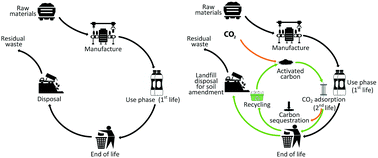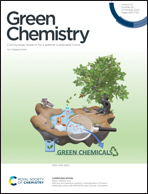Waste polyethylene terephthalate (PET) plastics-derived activated carbon for CO2 capture: a route to a closed carbon loop
Abstract
Global warming caused by CO2 emissions, and environmental pollution caused by waste polyethylene terephthalate (PET) disposal, are commonly considered as two stand-alone urgent environmental issues. However, using waste PET bottles as a carbon precursor to synthesise activated carbon (AC) for CO2 adsorption could provide a promising approach to solve the two environmental issues, simultaneously. Currently, it is still unclear whether such a solution could approach the aim of negative emissions based on a life cycle perspective. Therefore, this study assessed waste PET-derived AC coupled with temperature swing CO2 adsorption (TSA) to provide a comprehensive investigation on the potential life cycle environmental impacts. This study identified that this waste PET bottle-to-CO2 adsorbent approach could achieve negative CO2 emission, and thus provide an environmentally-friendly route to close the carbon loop. Nevertheless, the impacts of primary energy demand (PED) and water resource depletion (WU) would challenge its technical feasibility. In order to explore the key factors affecting the environmental impact, sensitivity analysis on CO2 capture, the heat source required for CO2 desorption, as well as bottle to bottle (B2B) recycling, were performed, and the major finding implies that replacing conventional heat sources by those from biomass can significantly decrease the PED impact. In addition, when recycled PET flakes were used for PET production, the life cycle impacts of WU decreased over 25%.



 Please wait while we load your content...
Please wait while we load your content...